Soviet SLR Systems - the beginnings
Here at worldcameras we also take an interest in older gear. We sometimes shoot film and also enjoy using manual focus lenses, on both vintage bodies and modern DSLRs. Due to our location in Eastern Europe, the most plentiful pre-digital gear available here is of Soviet origin. Before getting to the Soviet lenses however, a little background on the cameras they were made for.
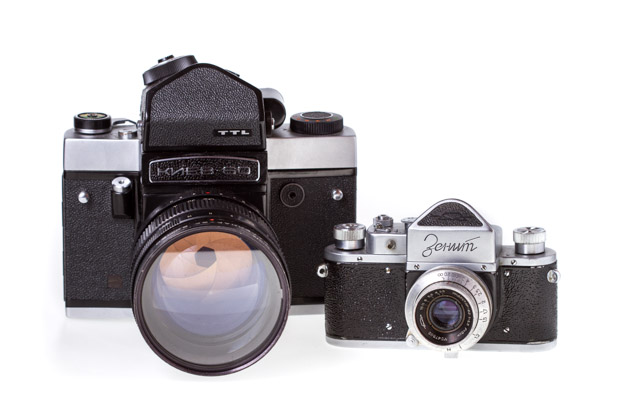 Kiev 60 6x6 MF SLR from 1988 and Zenit, the first Soviet SLR, from 1954
Kiev 60 6x6 MF SLR from 1988 and Zenit, the first Soviet SLR, from 1954
The image above represents the opposite ends of the spectrum we are going to cover. On the right, we have the 35mm Zenit from 1954, the first Russian pentaprism SLR. At the other end of the scale (in more ways than one), we have the Kiev-60 medium format (6x6) SLR. Kiev is the capital of Ukraine and that is where this camera was made. Because of that, it would be inaccurate to only talk about "Russian" lenses and cameras, as photographic equipment was also produced in other parts of the Soviet Union, such as Ukraine and Belarus.
This Kiev-60 is here also to represent the end of an era - it is from 1988. A year later, the Berlin wall would fall; in a few short years, lenses would be made of plastic instead of metal and the Soviet Union would disintegrate. OK, so maybe the plastic 50mm Zenitar M2S did not actually cause the collapse of the Soviet Union and from what I hear, it's a decent lens, but it is already from a different time and a different state.
The manufacturers of these two cameras - KMZ in Krasnogorsk near Moscow and Arsenal in Kiev - were the two major players in the Soviet SLR "market", but they were not the first Soviet camera builders. Cameras were built in Russia in the 19th century, and of course, they were also needed after the Russian revolution of 1917. The civil war, famine and political turmoil of the years that followed meant that taking photos of the march towards communism would have to wait a while - the first mass-produced Soviet cameras came along in 1929/1930. They were EFTE from Moscow (around 50 000 produced) and Fotokor (for "Photo Correspondent"; over a million produced) from Leningrad, both 9x12 folding plate cameras, inspired by German designs of the time. Initially, imported lenses and/or shutters were used.
Soon thereafter, even more interesting developments took place. First, during 1932-34, the youth labour commune "FED" (named after Felix Edmundovich Dzerzhinsky, founder of the infamous Soviet secret police) in Kharkov, Ukraine, decided to move on from making power drills and started producing 35mm rangefinder cameras, close copies of the German Leica II.
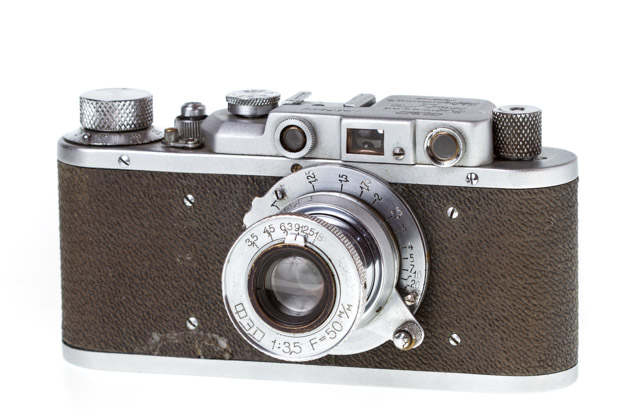 FED from 1938. The odd aperture sequence indicates a pre-war lens.
FED from 1938. The odd aperture sequence indicates a pre-war lens.
At about the same time, GOMZ (The State Optical-Mechanical Factory, makers of the Fotokor) in Leningrad was working on a far more original concept. This was the Gelveta/Sport, a camera using paper-backed 35mm film in 50-exposure cartridges. The Sport was made special by its reflex viewfinder - it is in the running for the title of the world's first 35mm SLR (along with the German Ihagee Kine-Exakta). Its 50mm f/3.5 lens was on a bayonet mount, but no other lenses for the "Sport" are known. Some 20 thousand "Sports" were produced between 1936 and the start of World War II.
In early 1941, several Moscow-based optical-mechanical workshops were to be reorganized into a new entity, located in Krasnogorsk, a northwestern suburb of Moscow, but this was rather abruptly interrupted by the German invasion of the Soviet Union in June 1941. The rapid German advance meant that hundreds of industrial facilities had to be repurposed and evacuated to safety beyond the Ural mountains. Among them was the FED commune, which ended up making aircraft parts in Berdsk, closer to Mongolia than Moscow.
The defenses of Moscow, however, held and by early 1942 the Germans had been driven back far enough for the optical works to resume operations in Krasnogorsk. This is when the KMZ (Krasnogorsk Mechanical Factory) was officially born. Initial production was, of course, to support the war effort. This included binoculars and optical gunsights, but also the Photo-Sniper, an SLR camera of sorts, basically a FED rangefinder with a mirror box and a 300mm lens in front, all mounted on a wooden gunstock, fired via the trigger, just like a gun.
With the defeat of the Nazi Germany looming, the race was on between the (soon-to-be-former) allies in the East and West to secure German industrial facilities and the engineering minds behind them. As far as optical engineering and photographic equipment were concerned, the grand prize was the Zeiss company, with its factories in Dresden and Jena ending up in the Soviet occupation zone, but not before the Americans had managed to haul off some key personnel from Jena to the American zone in the West, where they later formed the foundation of the "western" Zeiss company.
The Russians didn't waste much time either. KMZ benefitted the most from German know-how, parts and tooling, particularly in the area of photographic optics. KMZ's first production cameras, the 6x9 folders Moskva and Moskva 2 from 1946-47 were Zeiss copies, made mostly with original German tooling and even parts. With the FED factory destroyed in the war and its remaining people and equipment scattered in Siberia, KMZ was also tasked with producing 35mm rangefinders based on FED cameras. KMZ rangefinders got their own name in 1948 (Zorki - sharp-sighted) and began to drift apart from their FED precursors, the production of which was also slowly resumed in Kharkov.
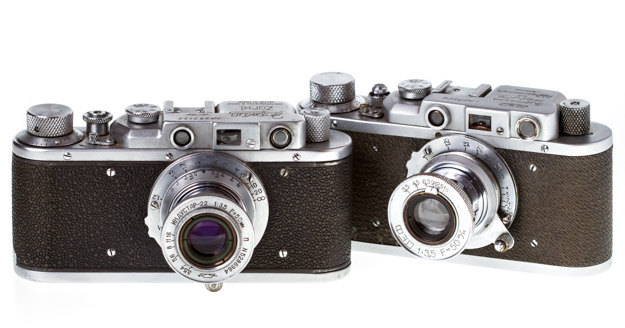 Zorki 1 from 1952, still looking very similar to the pre-war FED. Note the lack of coating on the FED lens.
Zorki 1 from 1952, still looking very similar to the pre-war FED. Note the lack of coating on the FED lens.
But Leicas that FEDs and Zorkis were based on, were not the only 35mm rangefinders in pre-war Germany. Zeiss had their Contax II and III, which were in many ways technically more advanced than the Leicas. The Soviets decided that these advanced cameras should now be manufactured in the Soviet Union, but they didn't fancy hauling the bombed-out remains of the Contax production line back to Russia and then trying to figure out how to put together the tools to put together the cameras.
Instead, production was set up in East Germany and then moved to the Soviet Union in 1947 as war reparations, along with some key engineers. The recipient of this rather substantial injection of German technology was the Arsenal factory in Kiev, Ukraine. The Arsenal military works dated back to the 18th century and although they had no background in photographic equipment, they did have a reputation for precision mechanical engineering and production. This was a good fit for the complex Contax (now renamed Kiev) cameras, with their high-precision rangefinders, double bayonet lens mounts and even lightmeters on Kiev III models.
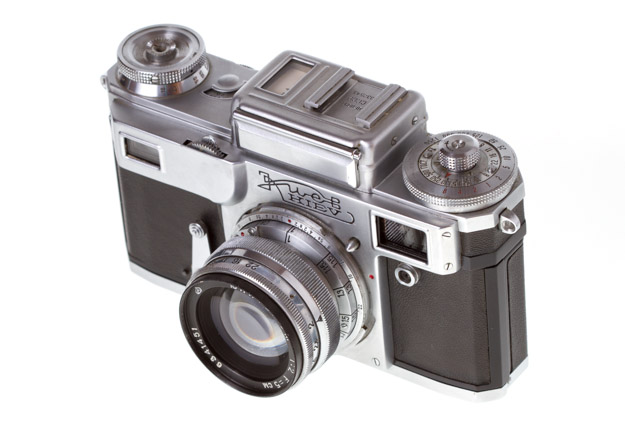 This Kiev 4 is from 1963, but an early fifties Kiev III would have looked fairly similar
This Kiev 4 is from 1963, but an early fifties Kiev III would have looked fairly similar
So, by 1950 it was pre-war Germany all over again in the Soviet 35mm camera industry, with FED and KMZ producing Leica clones and Arsenal firing back with the Kiev/Contax. But which of them would be the first to come up with a 35mm SLR - the camera format that would dominate much of photography during the rest of the 20th century?
Birth of the Soviet SLR
At the end of the previous article, the year was around 1950 and the Soviets were busy cranking out rangefinder cameras at three factories - FED in Kharkov, KMZ near Moscow and Arsenal in Kiev.
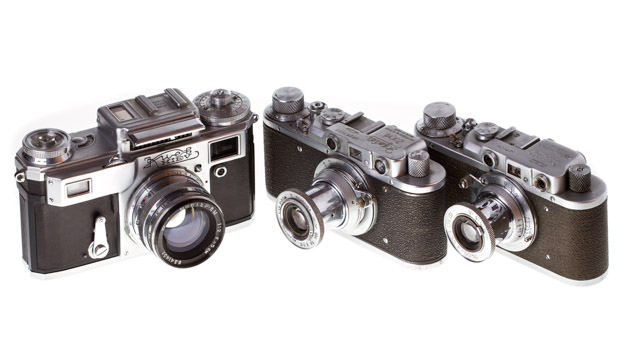 The Soviet rangfinder trio - Kiev, Zorki and FED.
The Soviet rangfinder trio - Kiev, Zorki and FED.
Still, the rangefinder concept had its shortcomings since the actual picture taking lens was not providing the image in the viewfinder. This caused a need for external viewfinders for lenses of different focal lengths, an inability to accurately focus longer lenses (rangefinder lenses usually top out at 135mm) and a parallax error when focusing close.
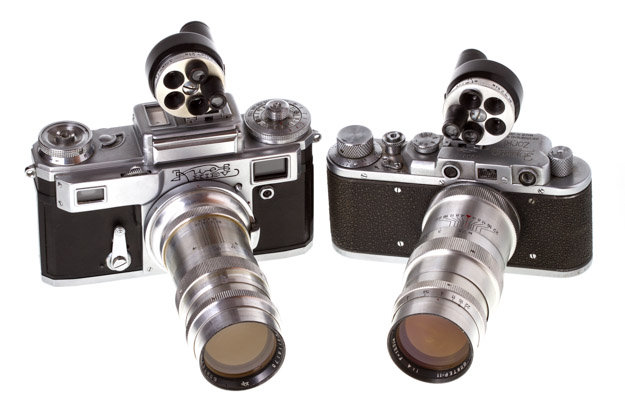 Kiev and Zorki with 135mm lenses and universal "turret" viewfinders for 28-35-50-85-135mm lenses
Kiev and Zorki with 135mm lenses and universal "turret" viewfinders for 28-35-50-85-135mm lenses
Early SLRs solved these problems by reflecting the image from their lens onto a ground glass, but this approach had some issues as well. Because a single mirror was used, the image on the ground glass was flipped left-to-right and things only got more confusing when trying to shoot in portrait orientation. The image on the ground glass was also rather small, at least on 35mm cameras, and difficult to see in bright light and/or at small apertures.
Although there were earlier attempts to solve these issues and provide an eye-level viewfinder (such as Duflex from Hungary, using additional mirrors) and parallel efforts in Italy (Rectaflex) and Switzerland (Alpa Prisma Reflex) employing pentaprisms, it is the East German Contax S from 1949 that is widely credited for being the first 35mm pentaprism SLR. The "S" in Contax "S" stood for "Spiegel" (mirror in German) to differentiate it from Contax rangefinders, although the camera itself was, in fact, labelled just "Contax". Aesthetically, the relation to Contax rangefinders is quite evident, but technically, not much could be carried over. In particular, the Contax RF vertical travel shutter mechanism occupied the same space where the pentaprism needed to be, so a more conventional horizontal travel shutter was implemented.
The Soviets ended up on a different path with their first pentaprism SLR project, led by Ivan A. Turygin - a man who had his hand in quite a few events that shaped the early Soviet camera industry. He designed "the first Soviet lens" - the Ortagoz - for the Fotokor camera, taught optical engineering before and after WWII, was in charge of evacuating the Krasnogorsk facilites at the start of WWII and, as major Turygin of the Soviet Armed Forces, was the ranking military offical at the Zeiss facilities between 1945 and 1947. There he was briefed on the development of Contax S as early as autumn 1945 by its chief engineer, Wilhelm Winzenburg. After returning to Moscow, Turygin held top level engineering and R&D positions at KMZ and oversaw the start of Moskva and Zorki production.
It's hard to tell how Turygin was influenced by his exposure to the Contax S program, but a few years later, development of the first Soviet pentaprism SLR - the Zenit - was under way at KMZ. And since KMZ was already producing Zorkis, this new camera wasn't based on a Contax, but the quintessential purist rangefinder, the Leica/Zorki. Shutter and film transport mechanisms could be reused from the Zorki; the rangefinder system was removed and replaced by a mirror, a focusing screen and a prism.
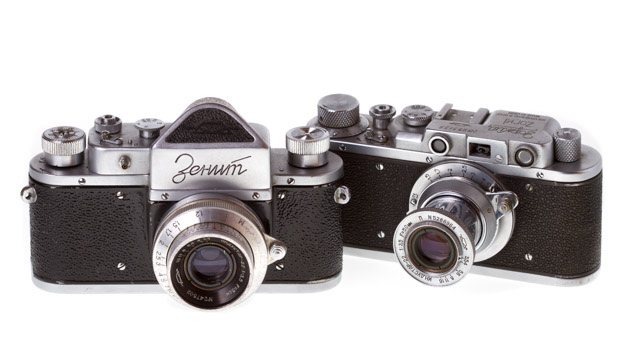 The Zorki 1 from 1952 on the right was the basis for the Zenit SLR.
The Zorki 1 from 1952 on the right was the basis for the Zenit SLR.
As the mirror housing required more room in front of the shutter, the lens mount was moved forward, but the mount itself remained the same - M39. The flange-to-film distance increased from the Leica/FED/Zorki standard of 28,8mm to 45,2 millimeters.
 Industar 22 kit lens is shorter on the SLR to compensate for the longer flange distance
Industar 22 kit lens is shorter on the SLR to compensate for the longer flange distance
The earliest prototype Zenits were built around 1950 and had an angular prism housing similar to the Contax S; later it became rounded, maybe because it fit better with the rounded sides of the body. Series production started in 1952 with only some 200 units and increased to around 19 000 cameras for both 1954 and 1955. The first Zenit lacked many features that later became commonplace and made handling simpler and quicker, such as a film advance lever (the Zenit had a rotating knob), instant return mirror (unless the shutter was cocked, the mirror was up on the Zenit, so no image in viewfinder), and an opening back (the Zenit had a removable baseplate, just like early Zorkis and Leicas; in fact, the part is reportedly interchangeable between all three).
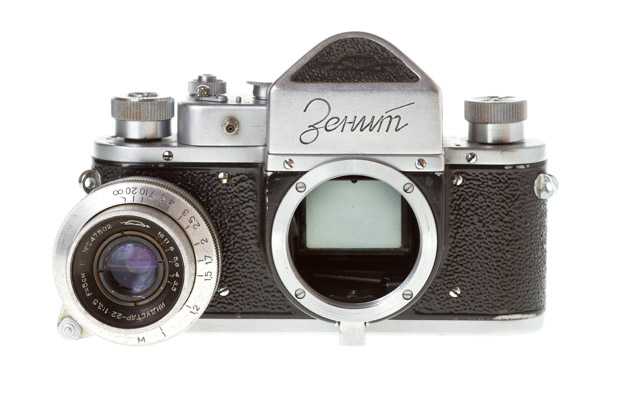 Yup, there's a mirror in there. Glossy black finish on the body and flash sync are not original on this 1954 Zenit.
Yup, there's a mirror in there. Glossy black finish on the body and flash sync are not original on this 1954 Zenit.
But the Zenit was nevertheless a significant achievement - it was among the first 4 or 5 pentaprism SLRs in the world, ahead of all the Japanese manufacturers and even Leica itself. Actually, the first Zenit is probably as close to a Leica SLR as it gets for screw-mount Leica fans - a traditional, very compact, handsome and functional shape with all the SLR advantages. Leica didn't get around to making an SLR until 1964 and the resulting camera was far enough from the Leica tradition to earn the nickname "diesel-Leica".
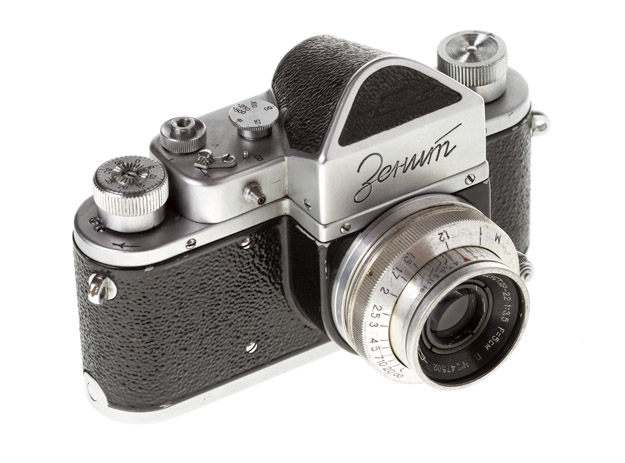 An SLR Leica, as conceived by Soviet engineers
An SLR Leica, as conceived by Soviet engineers
M39 SLR Lenses
As Zenit, the first Soviet pentaprism SLR, was derived from the Leica-inspired Zorki rangefinder, it ended up sharing the same M39 lens mount. More accurately, the M39 mount used by the Soviets is a fully metric mount, with a diameter of 39mm and a thread pitch of 1mm. This is slightly different from the original Leica thread mount (often called LTM) that had the same diameter but an imperial thread pitch of 26 threads per inch, which comes to 0.977 millimeters. The difference is small enough that one can generally cross-mount M39/LTM equipment without problems.
Using the same M39 mount on FED/Zorki rangefinders and early Zenit SLRs does create some potential for confusion, as you can put RF lenses on SLRs and vice versa, but they will not work quite as intended. This is because the flange distance (distance from the lens mount to the film plane) needs to be bigger on SLRs to accomodate the moving mirror between the lens and the film. So a rangefinder lens on an SLR will be further away from the film plane than intended and this has the same effect as an extension tube for macro photography - the lens will focus a lot closer and will not be able to attain infinity focus. Here are some samples of how the focusing range shifts:
| Focal length | Focusing range on RF | Focusing range on SLR |
|---|---|---|
| 50mm | 1m - infinity | 27 - 30cm |
| 85mm | 1.15m - infinity | 50 - 60cm |
| 135mm | 2.5m - infinity | 1 - 1.3m |
The focusing range becomes so small because the focusing movement on the lens is small compared to the "extension tube" effect; longer lenses retain a more usable focusing range. But if you want to use M39 lenses normally on an SLR, you need to be sure you actually have an SLR lens, not a rangefinder lens. The following table lists all Soviet M39 SLR lenses and also if there is a RF version that you need to watch out for.
| Lens name | In Russian | Focal length | Max. aperture | Rarity | RF version exists |
|---|---|---|---|---|---|
| Mir 1 | Мир 1 | 37mm | 2.8 | common | no |
| Industar 22 | Индустар 22 | 50mm | 3.5 | uncommon | yes |
| Industar 50 | Индустар 50 | 50mm | 3.5 | very common | yes |
| Vega 1 | Вега 1 | 50mm | 2.8 | very rare | yes |
| Helios 44 | Гелиос 44 | 58mm | 2 | very common | no |
| Jupiter 9 | Юпитер 9 | 85mm | 2 | uncommon | yes |
| Helios 40 | Гелиос 40 | 85mm | 1.5 | uncommon | no |
| Industar 24M | Индустар 24M | 105mm | 3.5 | rare | no |
| Jupiter 11 | Юпитер 11 | 135mm | 4 | very common | yes |
| Tair 11 | Tair 11 | 135mm | 2.8 | uncommon | no |
| Jupiter 6 | Юпитер 6 | 180mm | 2.8 | uncommon | no |
| Jupiter 21 | Юпитер 21 | 200mm | 4 | uncommon | no |
| Telemar 22 | Телемар 22 | 200mm | 5.6 | uncommon | no |
| Tair 3 | Таир 3 | 300mm | 4.5 | uncommon | no |
| MTO-500 | МТО-500 | 500mm | 8 | uncommon | no |
| MTO-1000 | МТО-1000 | 1000mm | 10 | uncommon | no |
Mir 1 was the widest Soviet M39 SLR lens, so anything wider in M39 mount (Jupiter 12 35mm, Orion 15 28mm, Russar 20mm) will be a RF lens; also note that anything above 135mm is SLR-only; I don't know enough about those to accurately comment on their rarity, but they are all probably at least uncommon.
Telling apart M39 mount SLR and RF lenses
Below we have some comparison pictures, RF lens on the left, SLR version on the right. These Industar 22s are a very obvious case, because the RF lens is a collapsible version - the lens barrel can slide back inside the camera body for a more compact package when not shooting. None of the SLR lenses are collapsible, so that's a definite giveaway. There are actually rare non-collapsible or "rigid" versions of the RF Industar 22 as well, which look a lot like the SLR I-22, but the front part of the lens barrel is slightly longer.
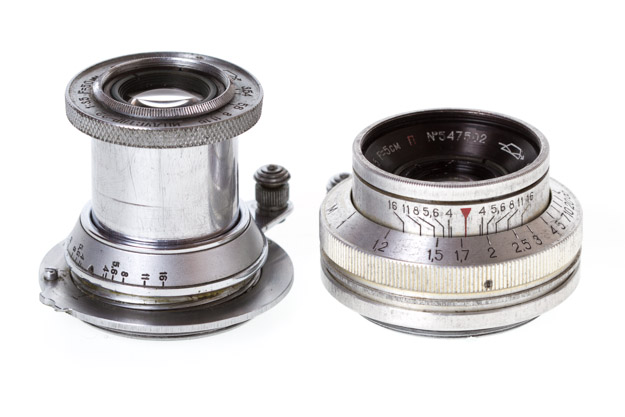 RF and SLR Industar 22 lenses
RF and SLR Industar 22 lenses
Collapsible Industar 50-s are common as well, but here we have the rigid version, which is pretty much the same as the SLR version to its right, except for the extension tube at the back that compensates for the shorter flange distance on RF cameras. There is actually an inner tube as well that connects to the rangefinder cam inside the RF camera; in theory you could unscrew both of these tubes and slap the lens on an M39 SLR and use it as normal; on my particular sample the inner tube seems stuck, however. There is another small difference - minimum focusing distance on the RF version is 1 meter (RF cameras just don't focus much closer than that), but the SLR version goes down to 65cm.
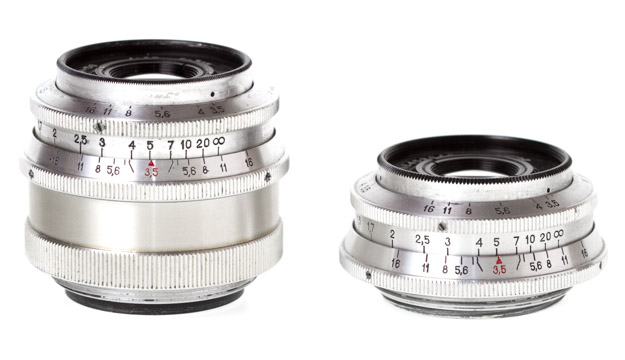 RF and SLR Industar 50 lenses
RF and SLR Industar 50 lenses
For the Jupiter 9 and Jupiter 11 pairs, RF vs SLR differences are quite similar - RF lenses are slimmer, but longer/taller, with most of the extra length at the back of the lens, below the focusing ring. SLR versions also have a two-ring preset aperture system, whereas RF versions have a simple single aperture ring.
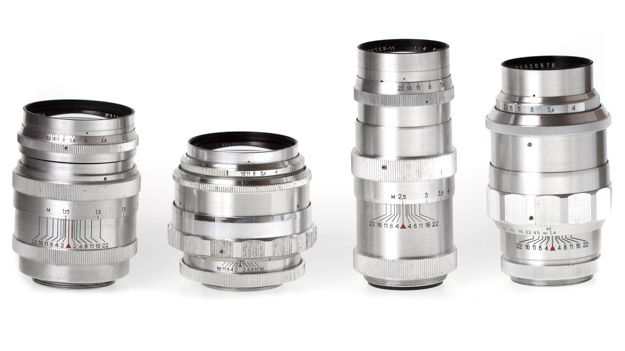 RF and SLR Jupiter 9, RF and SLR Jupiter 11
RF and SLR Jupiter 9, RF and SLR Jupiter 11
What is this preset aperture system?
On a fully manual SLR, you'll want to focus with the lens wide-open so that the point of focus is most clearly visible - because the depth of field is at its narrowest and the viewfinder image is at its brightest. But for taking the actual shot you might need to stop down to f/5.6 or f/11 or whatever and this would be difficult without taking the camera from your eye and looking at the lens aperture ring; you could count the click stops if the lens has them, but that gets tedious pretty quickly, too.
One of the solutions is preset aperture. The most common version of this system (at least on Soviet SLR lenses) works with two aperture rings and can be confusing if you are not familiar with it. One of the rings (usually the one closest to the front of the lens) has click stops and sets the aperture you want to shoot at - in both of the pictures below it is set to f/8. But this ring does not actually close down the aperture to that setting - this is done by the second ring below it. The second ring does not have click stops and rotates smoothly, changing the actual lens aperture between wide open and the value you set on the first ring. So when you shoot, you set the shooting aperture with the first ring and then move between wide open (for focusing) and your selected aperture (for shooting) by rotating the second ring from one end of its travel to the other - no need to take your eye away from the viewfinder.
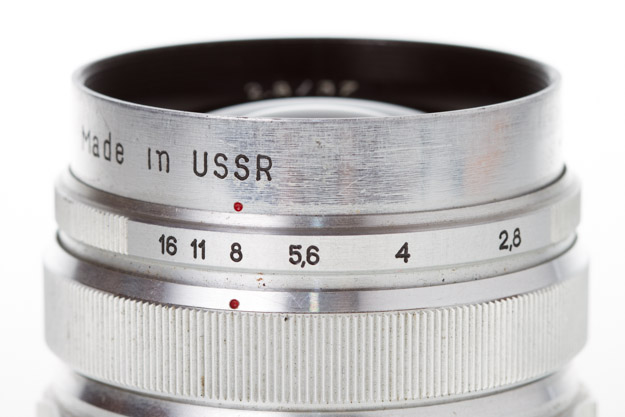 Aperture preset to f/8 by the top ring, but lens actually wide open because of the second ring position
Aperture preset to f/8 by the top ring, but lens actually wide open because of the second ring position
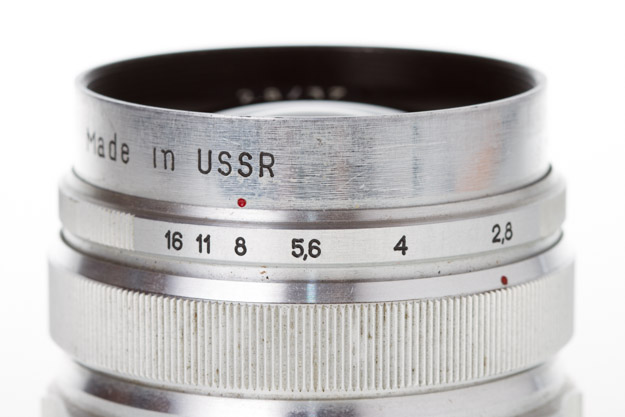 Aperture preset to f/8 and the lens actually stopped down to f/8 by the lower ring
Aperture preset to f/8 and the lens actually stopped down to f/8 by the lower ring
No, the images above are not mixed up! :) For some curious (maybe technical?) reason, the second ring is "reversed" on most Soviet lenses so that the aperture is wide open when the indicator dot on the second ring points to the shooting aperture and stopped down when the ring is rotated to the widest setting. That is how you get forum posts about "someone assembled the aperture mechanism on my Soviet lens wrong and it operates in reverse". Additionally, if the function or even the very existence of the first ring is unknown and it's set to - let's say f/5.6 - we get "help, my aperture is broken - it operates in reverse and won't stop down beyond f/5.6 or so" :)
There are also preset systems with one or two rings where one of the rings has to be pushed down to select the shooting aperture, but such systems can mostly be found on M42 lenses, with the exception of a very early and quite rare version of the M39 Helios 44.
Lens markings and year of manufacture
M39 SLR lenses were produced between about 1952 (birth of the Zenit SLR) and 1968-1970 (when M42 became the dominant standard). KMZ, as the manufacturer of the Zenit and a major recipient of Zeiss optical know-how, was the leading factory for M39 lenses. Lenses were often prototyped and initially made at KMZ, but later the production was in many cases handed over to sister factories. The following lenses illustrate the basics.
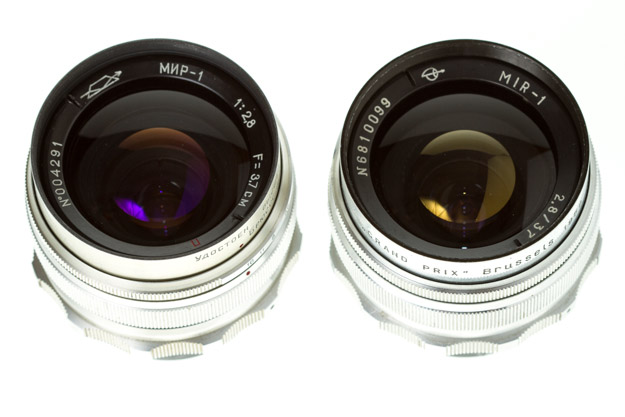 Two Mir 1s, a KMZ lens from 1958 and a Zagorsk factory lens from 1968
Two Mir 1s, a KMZ lens from 1958 and a Zagorsk factory lens from 1968
On the left, we have a KMZ Mir 1 from 1958. This lens shows some of the earliest marking styles used on SLR lenses - focal length is in centimeters, preceded by "F=". Near the 5 o'clock position you can just make out the red "П" (russian letter "P") symbol, derived from the Zeiss "T" and indicating a coated lens. All Soviet SLR lenses are coated, but in the fifties it was still considered a feature important enough to warrant a mention on the lens itself.
It is common for the first two digits of Soviet lens serial numbers to indicate the year of production (the 68 on the other Mir 1 tells us that the lens is from 1968), but the earlier Mir has a 00 serial - what's up with that? There has been speculation that such serial numbers indicate special versions of lenses, with better quality, made for party bosses and the KGB or what not, but there is little to no proof of that. A serial with several leading zeros does indicate an early lens in the series, maybe even a prototype for really low numbers, but sometimes the year prefix just wasn't used and a large number of 0-serial lenses was produced.
The Mir 1 on the left, however, is rather special because of its early style markings and the fact that KMZ only produced them for a couple of years, before production was moved to Zagorsk in around 1963. You can see the different factory logo on the 1968 sample, along with simplified markings that were adopted for 1961 or thereabouts - no more red "P" and shortened aperture/focal length markings (2,8/37).
Next up, some Helios 44s, perhaps the most well-known of Soviet SLR lenses. Helios 44 replaced Industar 22 and its successor Industar 50 as the kit lens for most Zenits when it was introduced in 1960 (although prototypes had existed in the early 50s). In the picture below, we have four of them, but only three are M39.
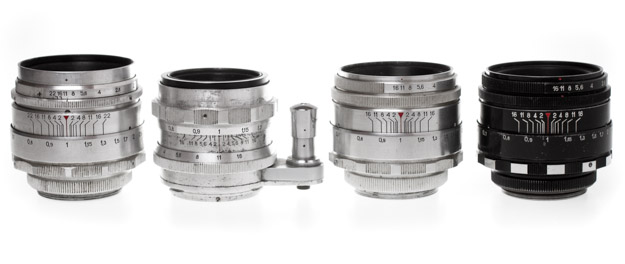 Four Helios 44 lenses from the 1960s; the one with the strange attachment is not M39, though.
Four Helios 44 lenses from the 1960s; the one with the strange attachment is not M39, though.
The second Helios 44 from the left is for the 1958-1964 "Start" camera, which had its own unique breech-lock mount. It's the only Helios 44 that is not readily adaptable to current cameras, so it is best avoided. It also features an early alternative to the preset aperture systems on other lenses - pressing the button to the right of the lens closes down the aperture to the selected value and then also engages the shutter button on the "Start" camera body. But let's now take a closer look at the other three 44s that are M39.
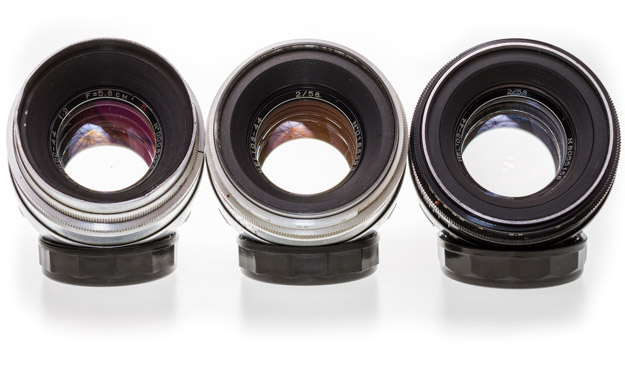
The leftmost lens is the earliest version to carry the Helios 44 name. It is distinctive because of its minimum aperture of f/22 and a different preset system, with one of rings that has to be pushed down instead of just rotating it. This system was not "reversed" like the common two rotating ring setup described above, but perhaps it was more complicated to produce and was thus discontinued.
This early version (with a triple zero serial, no less) is probably from 1960 and still has the early centimeter focal length markings and the red "P". The middle lens has the newer simplified markings and a single leading zero in its serial - probably some 300 000 of such lenses were made in the first half of the sixties. There isn't much to add about this Helios other than the fact that its serial probably dates it to 1963 and that it still has the more desireable 13-bladed aperture, which KMZ M39 Helioses up to around serial number 0240000 have.
It is also the earliest lens here with its name in Latin letters instead of Cyrillic - this supposedly indicates export versions of the lens and those are sometimes said to be of better quality (the search for better quality samples seems to be a running theme with these Soviet lenses :), but this is probably just another urban legend.
The black (actually "zebra", because the focusing ring also has unpainted shiny bits) Helios is already from another factory, MMZ in Minsk, Belarus. And, to make things more interesting (or confusing), they had their own numbering scheme for a while. The "80" at the start of the serial does not indicate a lens made in 1980 (by then production was all M42), but instead, just the first digit indicates the year of manufacture, in this case 1968.
So there you have it - centimeter and red "P" markings in the fifties, simpler markings in the 60s and some black/zebra lenses showing up towards the end of the sixties.
Using M39 SLR lenses on current cameras
M39 SLR lenses can be used on modern SLRs, but there are some things to be aware of. First, as far as I know, there are no direct adapters for M39 SLR lenses to any current SLR system, probably because the whole M39 SLR thing is a Soviet invention and very few such lenses were made elsewhere. The solution is a thin adapter ring that has an M39 thread on the inside (to screw onto the M39 lens) and an M42 thread on the outside that screws into commonly available M42 (aka Pentax screwmount) adapters.
 M39 SLR lens, M39 to M42 adapter ring and M42 to EOS adapter
M39 SLR lens, M39 to M42 adapter ring and M42 to EOS adapter
M42 adapters are available for most SLRs, but Nikon SLR flange distance (46.5mm) is too big for M42 lenses, so a simple adapter will lose infinity focus; an adapter with an optical element will reach infinity but with reduced image quality, so Nikon is not the ideal platform for M42 and M39 SLR lenses.
There is another issue, however, even with SLR systems that are compatible with M42 lenses. The M42 standard flange distance (45.5mm) is longer than the SLR M39 flange distance of 45.2mm. This means that using M39 lenses via an M42 adapter you again get the extension tube effect, although a tiny one, at just 0.3mm. It is still enough to throw off infinity focus, and you might be unable to get distant objects sharp, at least at wider apertures, unless the lens initially focuses beyond infinity or can be adjusted.
On mirrorless systems (such as Fuji X, Sony Nex, Micro 4/3 and Canon M), both RF and SLR M39 lenses can be used, but with different adapters. RF lenses should work with Leica thread mount adapters (denoted by LTM, L39 or (Leica) M39 markings), and SLR lenses again have to take the M42 adapter + M39 adapter ring route. Another option would be a Leica thread mount adapter plus the right extension ring - just like the piece used at the back of the RF Industar 50 towards the top of the article. Soviet M39 extension ring sets include just this exact length, presumably to enable the use of M39 SLR lenses on FED/Zorki rangefinders. This second option should have no problems with infinity focus.
And a final word of warning about filters - some early Soviet M39 SLR lenses use non-standard filter sizes/threads. For example, the M39 version of the famous Helios 40 has a 66mm filter size - no-one makes filters in this size and even step-up rings are very hard to find. Some early Helios 44 and Mir 1 lenses use filters with a 0,5mm thread pitch instead of the much more common 0,75mm - don't try to force modern filters on them, you'll ruin the threads.
 Newer Helios 44 on the right takes current filters, but not the older one on the left.
Newer Helios 44 on the right takes current filters, but not the older one on the left.
That's it, go find yourself a vintage M39 lens and try it out!